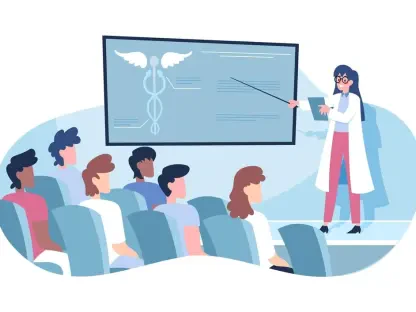The healthcare landscape has undergone significant changes primarily due to rapidly advancing technologies. These advancements have increased the necessity for prompt, effective, and individualized care. Among such technological advancements, the use of advanced analytics in clinical decision-making stands out as one of the most promising improvements. Advanced analytics are transforming the way healthcare providers make decisions, leading to better patient outcomes and improving operational efficiency.
Transforming Emergency Care
Lifesaving Insights
In emergency care settings, advanced data analytics are portrayed as lifesavers. Analytics provide critical insights into patient recovery patterns, aiding clinicians in making timely and informed decisions. By processing large volumes of patient data, such as vital signs, medical history, and lab results, advanced analytics can identify high-risk patients and facilitate early intervention. For example, analytics can detect patients at high risk of sepsis by evaluating variables like vital signs, blood tests, and medical history. Early recognition allows for immediate intervention, which may prevent severe complications.
Early Detection and Intervention
Predictive analytics also help anticipate the need for important resources, ensuring there are no delays in the treatment process. In addition to preventing adverse events, continuous monitoring data can signal other health risks such as cardiac arrest, thereby optimizing resource utilization and enhancing operational efficiency. This proactive approach ensures that critical resources are available when needed, improving overall patient care. By integrating these insights into emergency settings, healthcare providers can deliver more accurate and timely treatments.
Optimizing Resource Utilization
Moreover, the role of advanced analytics in identifying potential complications cannot be overstated. Early intervention made possible through predictive analytics helps to streamline patient flow and resource allocation. When healthcare providers have real-time access to patient data and predictive insights, they can optimize the use of hospital resources such as staff, equipment, and medication. This not only saves time and costs but also significantly improves patient outcomes by ensuring they receive appropriate care without unnecessary delays.
Integrating Data from Medical Devices
Real-Time Insights
The seamless integration of data from medical devices is another crucial aspect discussed in the article. Medical devices like patient monitors, anesthesia machines, and ventilators generate vast amounts of patient information. Integrating this data into powerful analytics platforms enables healthcare providers to glean real-time insights into a patient’s physiological status. This integration allows for rapid identification of potential complications and timely interventions. By consolidating diverse data streams into a unified platform, healthcare professionals can make better-informed decisions about patient care, thereby enhancing overall treatment efficacy.
Avoiding Adverse Events
This proactive approach helps avoid adverse events and enhances personalized care by analyzing historical data to improve evidence-based protocols and best practices. Moreover, integrating data from multiple medical devices provides a comprehensive view of a patient’s health status, allowing for early detection of issues before they escalate into serious problems. By continuously monitoring patient data, healthcare providers can quickly respond to any signs of deterioration, ultimately reducing the likelihood of adverse events and improving patient safety.
Enhancing Personalized Care
By leveraging data from various medical devices, healthcare providers can create more personalized care plans. This approach moves away from generic, one-size-fits-all treatments, leading to more effective strategies and better patient outcomes. Personalized care not only enhances the overall patient experience but also improves adherence to treatment regimens, as patients receive care tailored specifically to their unique needs. The ability to customize treatment plans based on real-time data ensures that patients receive the most appropriate and effective interventions, optimizing their chances for recovery.
Improving Outcomes in the ICU
Continuous Vigilance
The article emphasizes the crucial role of advanced analytics in ICU settings, one of the most demanding areas in healthcare. Continuous vigilance and quick judgment are vital for ensuring patient safety in the ICU. Advanced analytics assist healthcare personnel by combining data from multiple sources, including ICU charts, scoring systems, pain management protocols, and real-time vital sign measures. This integrated approach helps categorize patients based on risk levels, formulating effective treatment protocols and ensuring appropriate attention to critical patients.
Effective Treatment Protocols
By utilizing analytics to monitor and interpret these diverse data streams, healthcare providers can reduce ICU stays and improve patient outcomes. For instance, a study published in Critical Care demonstrated that machine learning models outperformed traditional scoring systems in predicting short-term mortality among critically ill patients. This not only enhances patient outcomes but also optimizes resource management, allowing ICUs to accommodate and manage more patients effectively. The ability to provide targeted interventions based on real-time data ensures that critically ill patients receive the care they need promptly and efficiently.
Optimizing Resource Management
Moreover, the integration of predictive analytics into ICU operations aids in resource optimization. By predicting patient outcomes and potential complications, healthcare providers can allocate resources more effectively, ensuring that critical patients receive the necessary attention without overburdening the ICU staff. This approach enables ICUs to handle more patients without compromising the quality of care. Additionally, predictive analytics help in managing ICU bed availability, ensuring that beds are allocated efficiently and that patients are transferred to other care settings as soon as their condition allows.
Risk Stratification and Personalized Care
Precision in Patient Stratification
In the domain of risk stratification and personalized care, the article highlights that advanced analytics have propelled healthcare to new heights, enabling unprecedented precision in patient stratification based on risk levels. This enhancement allows for better prioritization of care and resource allocation, ensuring that the most at-risk individuals receive timely and focused interventions. By accurately identifying patients who are at higher risk of complications, healthcare providers can implement preventive measures to mitigate those risks and improve patient outcomes.
Data-Driven Insights
Data-driven insights empower clinicians to detect imminent health risks and take preventive measures, improving overall patient safety. Additionally, advanced analytics facilitate the creation of personalized care plans tailored to individual patient needs and characteristics. This personalized care approach leads to more effective treatment strategies and better patient outcomes. By moving away from generic, one-size-fits-all approaches, healthcare providers can offer more targeted and efficient care. Personalized care plans also enhance patient adherence to treatment, as they are tailored to the patient’s specific health profile and preferences.
Moving Away from Generic Approaches
Moreover, the shift towards personalized care facilitated by advanced analytics helps in overcoming the limitations of conventional treatment methods. By analyzing a patient’s historical data and current health status, healthcare providers can develop customized treatment protocols that are more likely to be effective. This move away from generic approaches not only improves the accuracy and efficacy of treatments but also enhances patient satisfaction. Patients who receive personalized care are more likely to trust their healthcare providers and adhere to treatment recommendations, leading to better health outcomes and reduced healthcare costs.
Extending Care Beyond the Hospital
Remote Monitoring Technologies
Another significant benefit of advanced analytics is extending care beyond the confines of a hospital. By leveraging remote monitoring technologies and sophisticated data analytics, healthcare providers can offer continuous patient care in real-time, even outside a hospital setting. This capability ensures that patients with chronic conditions or those recovering from surgeries receive the necessary monitoring and intervention without the need for frequent hospital visits. Remote monitoring allows healthcare providers to keep track of patients’ health status, detect any anomalies, and provide timely interventions, thereby improving patient outcomes.
Reducing Hospital Visits
This reduces the number of hospital visits and ensures early detection and treatment of potential issues, leading to better patient outcomes and lower healthcare costs. Patients also benefit from the convenience and comfort of receiving care in familiar surroundings. The ability to monitor patients remotely also alleviates the burden on healthcare facilities and staff, allowing them to focus on more critical cases. Furthermore, remote monitoring technologies foster a sense of independence and empowerment among patients, as they can actively participate in managing their own health.
Enhancing Patient Satisfaction
Significant changes have swept across the healthcare landscape, primarily driven by rapidly advancing technologies. These technological advancements have created a pressing need for timely, effective, and personalized care. One of the most promising advancements is the application of advanced analytics in clinical decision-making. Advanced analytics involve the use of sophisticated algorithms and data-driven insights to assist healthcare providers in making more informed and precise decisions. This approach has been transformative, changing the way healthcare professionals diagnose and treat patients. By leveraging data, healthcare providers can predict potential health issues, tailor treatments to individual patients, and enhance the overall quality of care. Moreover, advanced analytics contribute to improving operational efficiency within healthcare facilities. They provide valuable insights into resource allocation, patient flow, and staff performance, leading to streamlined operations and cost reductions. This blend of improved patient outcomes and operational efficiency showcases the profound impact of advanced analytics on modern healthcare.









